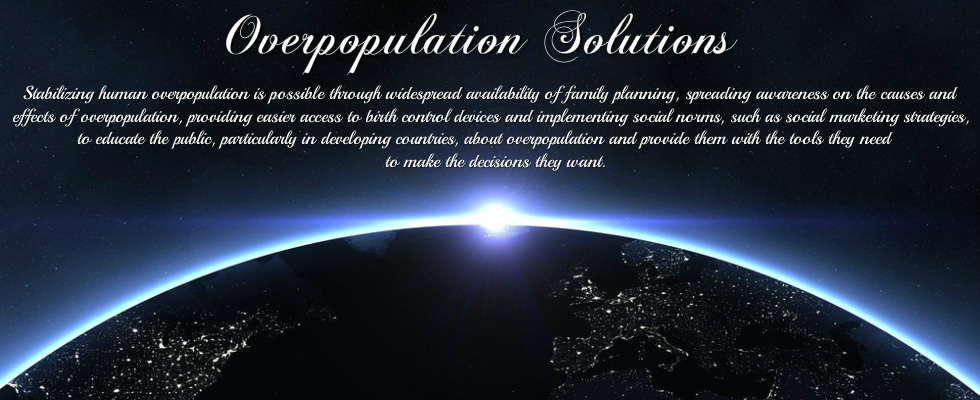
Overpopulation Solutions
In order to reduce the adverse impacts of overpopulation, mitigation measures, such as spreading awareness and education about overpopulation, enacting birth control measures and regulations, and providing universal access to birth control devices and family planning, must be taken. In countries like China, the government has put policies in place that
regulate the number of children allowed to a couple, and
some leaders and environmentalists
are suggesting that the United Nations implement a China-like one-child policy globally to help control and reduce overpopulation gradually. Others, such as
Gerard K. O'Neill,
Marshall T. Savage
and
John S. Lewis, have suggested building space habitats in asteroid belts or the Venusian atmosphere as viable solutions to successfully sustaining current population growth rates. Stabilizing human overpopulation, outside of relying on an undesirable United Nations global takeover of the bedroom or waiting to send future populations to space, is possible through widespread availability of family planning, spreading awareness on the causes and effects of overpopulation, providing easier access to birth control devices and
implementing social norms, such as social marketing strategies, to educate the public, particularly in developing countries, about overpopulation and provide them with the tools they need to make the decisions they want.
Worldwide, nearly 40% of pregnancies are unintended, which equates to about
80 million unintended pregnancies each year
and,
according to the United Nations Population Fund, an estimated 350 million women in the poorest countries of the world either not wanting their last child, not wanting another child or wanting to space their pregnancies, but lack access to information and affordable means and services to determine the size and spacing of their families. Even in the United States, in 2011,
almost half of pregnancies were unintended. The
Worldwatch Institute
has released
State of the World 2012: Moving Toward Sustainable Prosperity
and in the chapter "Nine Population Strategies to Stop Short of 9 Billion,"
Worldwatch Institute President Robert Engelman argues that, "If most or all of these strategies were put into effect, global population likely would peak and subsequently begin a gradual decline before 2050, thereby ensuring sustainable development of natural resources and global stability into the future. By implementing policies that defend human rights, promote education, and reflect the true economic and environmental costs of childbearing, the world can halt population short of the 9 billion that so many analysts expect."
Discover 'City Solutions'
"Short of nuclear war itself, population growth is the gravest issue the world faces. If we do not act, the problem will be solved by famine, riots, insurrection and war." ~ Robert McNamara, Former World Bank PresidentHow to Attain Population Sustainability
"Pressures resulting from unrestrained population growth put demands on the natural world that can overwhelm any efforts to achieve a sustainable future. If we are to halt the destruction of our environment, we must accept limits to that growth." ~ World Scientists' Warning to Humanity, signed by 1600 senior scientists from 70 countries, including 102 Nobel Prize laureates

- "Provide universal access to safe and effective contraceptive options for both sexes."
- "Guarantee education through secondary school for all, especially girls."
- "Eradicate gender bias from law, economic opportunity, health, and culture."
- "Offer age-appropriate sexuality education for all students."
- "End all policies that reward parents financially based on the number of children they have."
- "Integrate lessons on population, environment, and development into school curricula at multiple levels."
- "Put prices on environmental costs and impacts."
- "Adjust to an aging population instead of boosting childbearing through government incentives and programs."
- "Convince leaders to commit to stabilizing population growth through the exercise of human rights and human development."
Source: Worldwatch Institute: Nine Population Strategies to Stop Short of 9 Billion
"The colonization-followed-by-extinction pattern can be seen as recently as 2,000 years ago, when humans colonized Madagascar and quickly drove elephant birds, hippos, and large lemurs extinct. The first wave of extinctions targeted large vertebrates hunted by hunter-gatherers. The second, larger wave began 10,000 years ago as the discovery of agriculture caused a population boom and a need to plow wildlife habitats, divert streams, and maintain large herds of domestic cattle. The third and largest wave began in 1800 with the harnessing of fossil fuels. With enormous, cheap energy at its disposal, the human population grew rapidly from 1 billion in 1800 to 2 billion in 1930, 4 billion in 1975, and over 7 billion today. If the current course is not altered, we’ll reach 8 billion by 2020 and 9 to 15 billion (likely the former) by 2050." ~ Center for Biological Diversity


